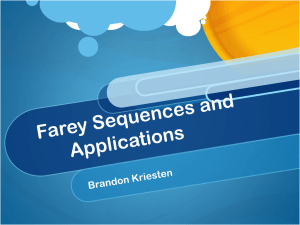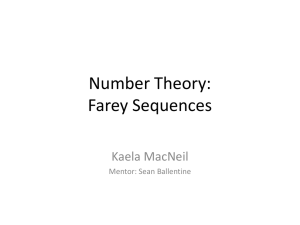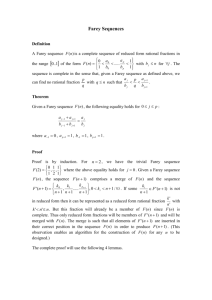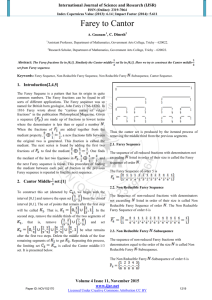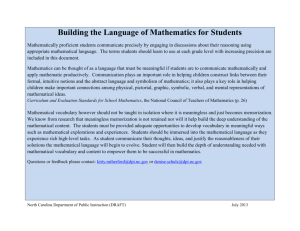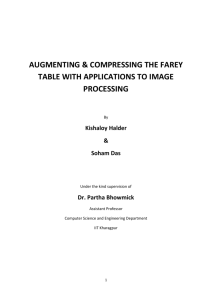Farey Series and Ford Circles Shi
advertisement
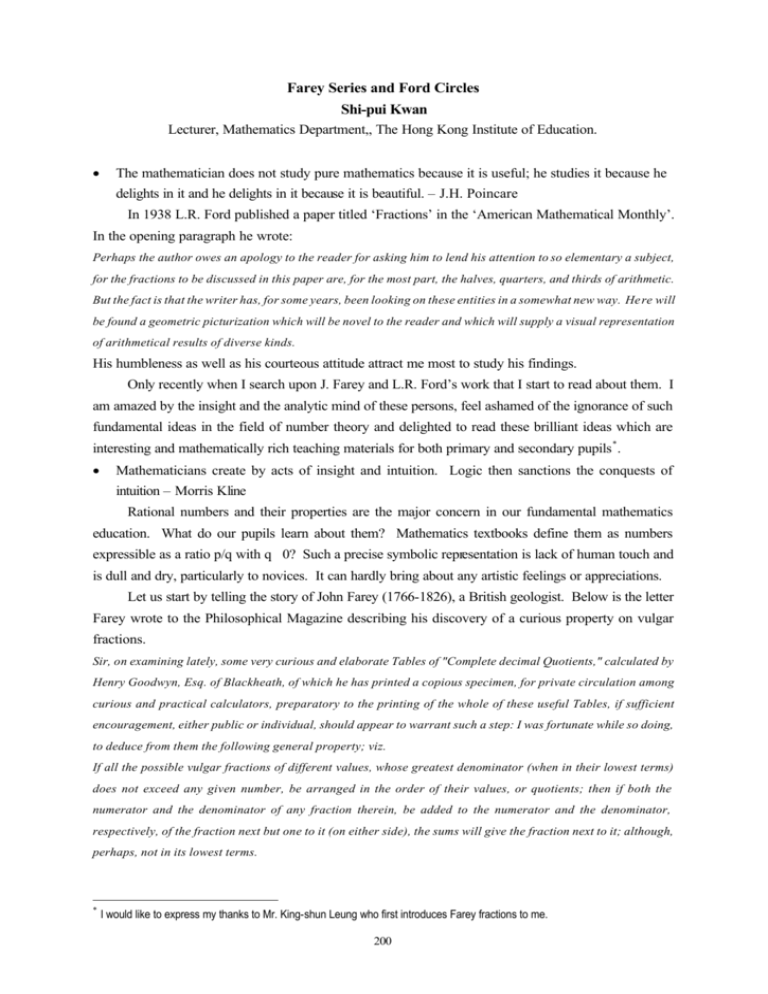
Farey Series and Ford Circles Shi-pui Kwan Lecturer, Mathematics Department,, The Hong Kong Institute of Education. • The mathematician does not study pure mathematics because it is useful; he studies it because he delights in it and he delights in it because it is beautiful. – J.H. Poincare In 1938 L.R. Ford published a paper titled ‘Fractions’ in the ‘American Mathematical Monthly’. In the opening paragraph he wrote: Perhaps the author owes an apology to the reader for asking him to lend his attention to so elementary a subject, for the fractions to be discussed in this paper are, for the most part, the halves, quarters, and thirds of arithmetic. But the fact is that the writer has, for some years, been looking on these entities in a somewhat new way. Here will be found a geometric picturization which will be novel to the reader and which will supply a visual representation of arithmetical results of diverse kinds. His humbleness as well as his courteous attitude attract me most to study his findings. Only recently when I search upon J. Farey and L.R. Ford’s work that I start to read about them. I am amazed by the insight and the analytic mind of these persons, feel ashamed of the ignorance of such fundamental ideas in the field of number theory and delighted to read these brilliant ideas which are interesting and mathematically rich teaching materials for both primary and secondary pupils * . • Mathematicians create by acts of insight and intuition. Logic then sanctions the conquests of intuition – Morris Kline Rational numbers and their properties are the major concern in our fundamental mathematics education. What do our pupils learn about them? Mathematics textbooks define them as numbers expressible as a ratio p/q with q 0? Such a precise symbolic representation is lack of human touch and is dull and dry, particularly to novices. It can hardly bring about any artistic feelings or appreciations. Let us start by telling the story of John Farey (1766-1826), a British geologist. Below is the letter Farey wrote to the Philosophical Magazine describing his discovery of a curious property on vulgar fractions. Sir, on examining lately, some very curious and elaborate Tables of "Complete decimal Quotients," calculated by Henry Goodwyn, Esq. of Blackheath, of which he has printed a copious specimen, for private circulation among curious and practical calculators, preparatory to the printing of the whole of these useful Tables, if sufficient encouragement, either public or individual, should appear to warrant such a step: I was fortunate while so doing, to deduce from them the following general property; viz. If all the possible vulgar fractions of different values, whose greatest denominator (when in their lowest terms) does not exceed any given number, be arranged in the order of their values, or quotients; then if both the numerator and the denominator of any fraction therein, be added to the numerator and the denominator, respectively, of the fraction next but one to it (on either side), the sums will give the fraction next to it; although, perhaps, not in its lowest terms. * I would like to express my thanks to Mr. King-shun Leung who first introduces Farey fractions to me. 200 For example, if 5 be the greatest denominator given; then are all the possible fractions, when arranged, 1/5, 1/4, 1/3, 2/5, 1/2, 3/5, 2/3, 3/4, and 4/5; taking 1/3, as the given fraction, we have (1+1)/(5+3) = 2/8 = 1/4 the next smaller fraction than 1/3; or (1+1)/(3+2) = 2/5, the next larger fraction to 1/3. Again, if 99 be the largest denominator, then, in a part of the arranged Table, we should have 15/52, 28/97, 13/45, 24/83, 11/38, &c.; and if the third of these fractions be given, we have (15+13)/(52+45) = 28/97 the second: or (13+11)/(45+38) = 24/83 the fourth of them: and so in all the other cases. I am not acquainted, whether this curious property of vulgar fractions has been before pointed out; or whether it may admit of any easy or general demonstration; which are points on which I should be glad to learn the sentiments of some of your mathematical readers; and am Sir, Your obedient humble servant, J. Farey. Assuming that you are the first to read the letter, what do you think about Farey’s conjecture? Follow his words and give more examples. Does his conjecture hold? How to prove it? The letter was translated into French and reached Cauchy’s hands. He supplemented Farey’s conjecture with proof and the results so disclosed bore Farey’s name. The set of all reduced fractions between the closed interval [0, 1] with denominators not exceeding n, arranged in order of their magnitude, is known as the Farey Series of order n, denoted by Fn .. For example, F5 = Given any three consecutive fractions in the Farey Series of order n, say a/b, a'/b' and a /b , a'/b'= (a+a )/ (b+b ), called the mediant fraction of a/b and a /b . It is well known to experienced teachers that many children have mistaken the fraction sum (a /b ) + (a'/b') as (a+a )/(b+b ) which is actually the mediant fraction of (a /b ) and a'/b'). ( Actually this fraction is no nonsense. It bears mathematical meanings. And the above neat characteristics within the aforesaid interval [0, 1] can be extended to the whole rational number line just by simple translation. More interestingly, it was found later that C. Haros had discovered the sequence with the complete proof in 1802 which was fourteen years earlier than Farey’s discovery. That is why some mathematicians have great reservations on the attribution of the series to Farey. Below are Hardy’s comments. Farey is immortal because he failed to understand a theorem which Haros had proved perfectly fourteen years before ... How about you? Do you agree with Hardy? And what are your opinions? • The mathematician’s best work is art, a high perfect art, as daring as the most secret dreams of imagination, clear and limpid. Mathematical genius and artistic genius touch one another. - Gosta Mittag-Leffler Geometrical interpretations help in concretizing abstract mathematical ideas. In many occasions it visualizes the concepts in presentable geometrical forms, yielding pretty images. Ford Circles are good examples. For any given point P (with value p/q) on the x-axis, take 1/q 2 as the diameter and coordinates (p/q, 1/2q2) as center, construct a circ le tangential to the x-axis at the given point. The circle so constructed 201 is called a Ford Circle. Coordinates of P = (p/q, 0) Radius OP = 1/ 2q2 O P For any given Farey Series of order n, if we plot all the fractions on the x-axis and draw their corresponding Ford Circles, they will form a set of fascinating touching circles. It is striking to see that Ford circles are either separated or just touches each other at a common point. They never cross! Is it just a coincident? Do you know why? Can you imagine what happens when n of Fn increases? How about extending the ideas to the whole axis and on both sides? 202 Are they beautiful? What do they look like? These figures are drawn by Geometer’s Sketchpad, a commonly use dynamic geometry software. Can they be served as proofs to the questions raised above? Why or why not? ² Teaching mathematics well is not science, but an art.– George Polya The study of Farey Series and Ford Circles is mathematically rich. That is to say they may lead to a wide range of learning in mathematics. Some examples are: 1. McKay’s Theorem and mediant fractions. (Sherzer 1973) 2. Methods of solution for linear Diophantine equations and Congruence Modulo Arithmetic. (Kriewall 1975) 3. Ford Circles generated from Farey Series of order n form a set of touching circles. (Ford 1938) 4. Connecting the study of Farey Series with computer programming. 5. Connecting the study of Farey Series with the advantages and limitations of using mathematics soft-wares in the study of mathematics. 6. Farey Series and Pick’s Theorem. (Honsberger 1985) 7. The History of Farey Series and development of mathematical ideas. (Bruckheimer and Arcavi 1995) Connecting Farey Series with the humanistic aspect of mathematics. 8. Just like mathematics, mathematics education has an artistic nature. With the same subject materials in our hands, it is up to us teachers to decide which approaches are to be adopted, resulting in highly diverse outcomes. What are the pros and cons in the design of the worksheet attached below † ? Farey’s Conjecture Having learned about Farey fractions, let us have a discussion on his findings. 1. Write down F7 . Explain Farey’s Conjecture by the F7 listed. 2. Among the three mathematicians, viz. Farey, Cauchy and Haros, whom do you like best? Why? † Further teaching materials are put in the web pages ‘Rational Fantasia’ http://www.math.ied.edu.hk/spkwan/art/INDEX.HTM for sharing purpose. 203 3. I think the appropriate value for n relating to the 1 mathematician (i.e. John Farey) we have n encountered today is _____. My reasons are: 4. Prove Farey’s Conjecture. 5. What are Ford Circles? How are they related to Farey Series? Start your library research. 6. Write a computer program to generate Farey Series Fn . How to guide our pupils to mathematics discovery like a mathematician? How to extend the problem and proceed with further mathematical investigations? Besides higher-order thinking, it is our responsibility to lead our children to appreciate the aesthetic and humanistic nature of mathematics. References: Bruckheimer, M. & Arcavi, A. (1995). Farey series and Pick’s area theorem. The Mathematical Intelligencer 17(2), 64-67. Conway, J. H. & Guy, R. K. (1996). The book of numbers. New York: Springer. Ford, L.R. (1938). Fractions. American Mathematical Monthly, 45(9), 586-601. Hardy, G.H. & Wright, E.M. (1979). An introduction to the theory of numbers. New York: Oxford University Press. Kriewall, T.E. (1975). “McKay’s Theorem” and Farey Fractions. Mathematics Teacher, 68(1), 28-31. Niven, I. et al (1991). The Theory of Numbers. New York: John Wiley & Sons. Honsberger, R. (1970) Ingenuity in Mathematics. Washington: Mathematical Association of America Sherzer, L. (1973). McKay’s Theorem. Mathematics Teacher, 66(3), 229-230. Farey Series http://www.cut-the-knot.com/blue/Farey.shtml Ford’s touching circles http://www.cut-the-knot.com/proofs/fords.shtml John Farey http://www-groups.dcs.st-and.ac.uk/~history/Mathematicians/Farey.html The Stern-Brocot Tree http://www.maa.org/editorial/knot/SB_tree.html 204
